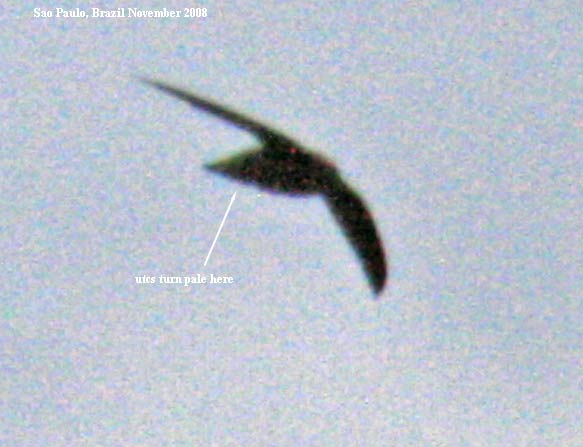
Update February 09, 2019: eBird now has a selection of almost 100 photos of Sick's Swift C. meridionalis available for study. Here are links to some of them that provide some comparisons to the Fort Clark bird below:
https://ebird.org/view/checklist/S38756276 .
https://ebird.org/argentina/view/checklist/S39520593 .
https://ebird.org/view/checklist/S49494428 .
https://ebird.org/brasil/view/checklist/S49746853 .
https://ebird.org/view/checklist/S42997818 .
https://ebird.org/view/checklist/S44934618 .
https://ebird.org/view/checklist/S48329145 .
https://ebird.org/brasil/view/checklist/S50277628 .
https://ebird.org/view/checklist/S45718292 . - I have enlarged the photo from this list, and placed it into the images below, for comparison.
Update March 11, 2009: CLICK HERE to see specimens of Sick's Swift C. meridionalis compared to pelagica and other relevant Chaetura taxa; I've also added extra annotated images of the Texas swift plus another Sick's Swift from SE Brazil - go to the bottom of this page:
Update December 03, 2008: I've added some not-very-good images of Sick's Swift from SE Brazil that I took recently - go to the bottom of this page:
Update December 02, 2008: On the late afternoon of November 11, 2008, I studied a party of 4 - 6 Sick's Swifts (Chaetura [andrei] meridionalis) feeding over a marsh east of Sao Paulo, southeastern Brazil: I was struck by the similarity to the Texas Chaetura, especially the pale "rump" extending to the tip of the short tail and the slight but visible paler undertail coverts contrasting with a dark underbody - that in turn contrasted strongly with a quite pale throat. The birds were feeding fairly low over the low scrub and water, and twice I saw one swoop down to drink, so I observed them in much the same manner as I did the bird at Fork Clark, Texas. I am seriously entertaining the thought that the bird I photographed in Texas was a Sick's Swift. Given that Sick himself noted (northbound) migrants in the Tepui region in May, the Texas bird fits a pattern of late Autumn overshooting - perhaps by a first-winter individual?
This Chaetura swift was drinking
from the spring pool at Fort Clark Springs, Brackettville, Kinney
County, Texas on May 19, 2005: Note that the day was overcast,
producing an even but brightish light (this was at c. 3pm in the
afternoon) - thus there is little strong light to cause misleading
contrasts, and the pics below are a fairly accurate representation
of the bird in life:-
The most striking feature was the pale uppertail coverts,
rump and lower back: note that this profile shot - taken
in a duller moment - is probably less prone to reflective distortion
than the pics further down that show the bird going away from
the lens - in real life the bird looked like this image - i,e,
with a clear contrast between the rear and front halves of the
body.
Also note the short tail compared to the wings:
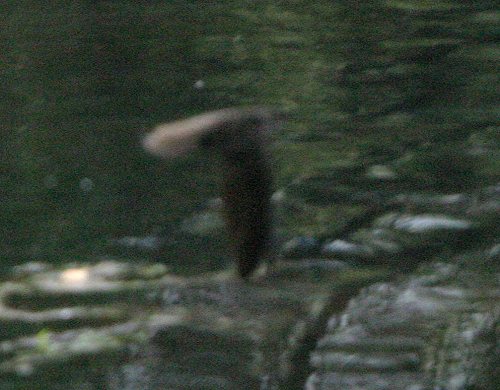
The forehead seems to be a bit paler, the pale gray of
the cheeks comes up behind the eye, the very pale throat appears to abruptly change to a dark tone on the upper chest, and the dark lores appear to be pinched a bit ahead of the eye:
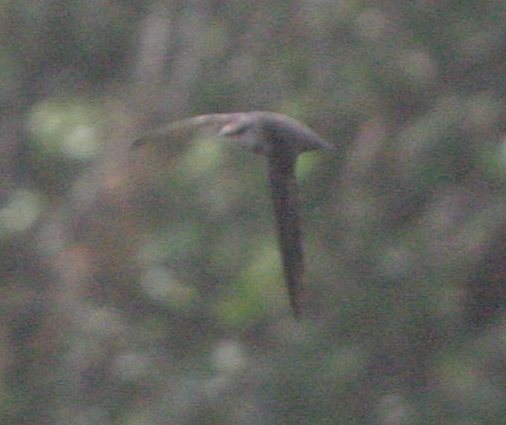
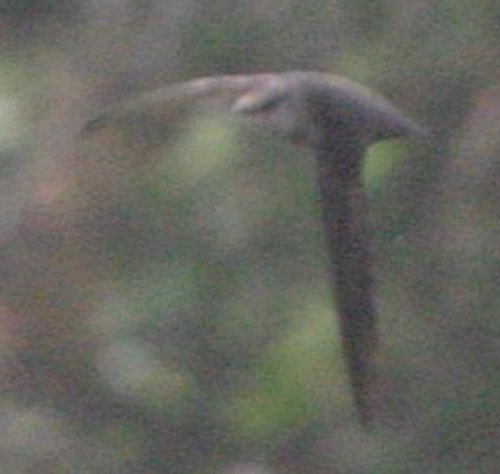

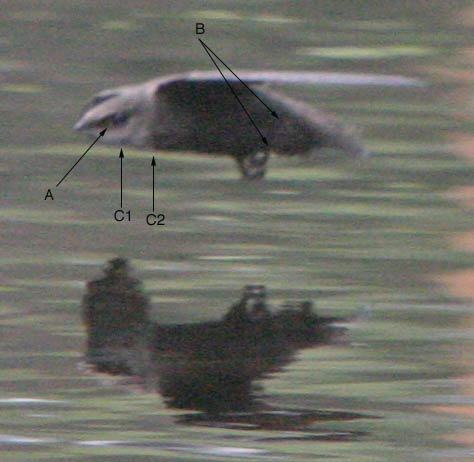
In this profile shot note the pale crescent ahead of the eye, breaking the dark lores (A); the fairly clean transition to slightly - but obviously - paler undertail coverts (B); the underparts changing from whitish on the chin/upper throat to very dark on the chest in a narrow area of the lower throat (C1 - C2); NEW FEB 2019: compare with this Sick's Swift:
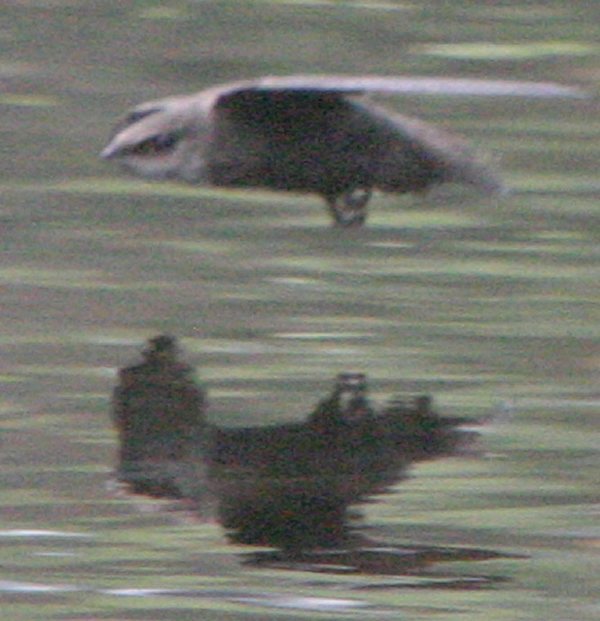
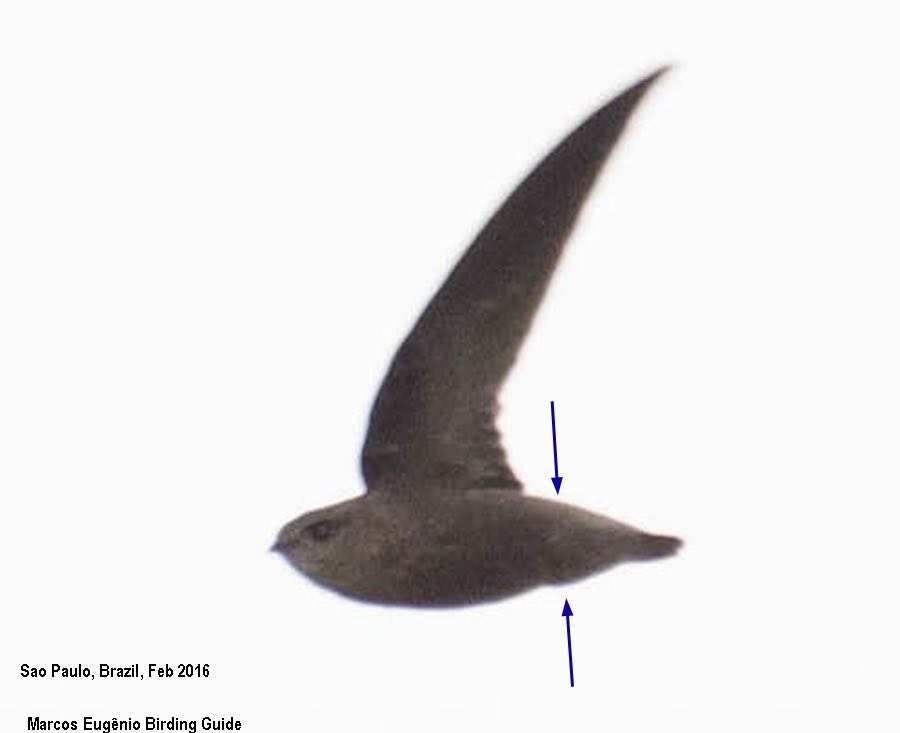
note this the pic below that with the bird a bit higher from the
water, the reflection shows distinctly paler undertail coverts
- this can also be seen slightly on the side of the actual bird:
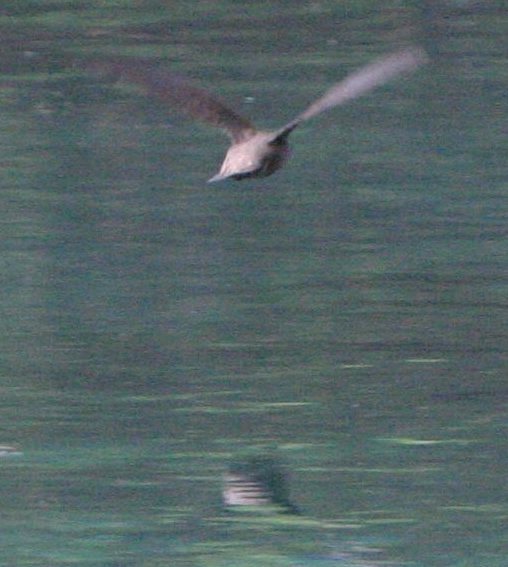
in enlargement below, note the indicated pale area on the lateral undertail coverts - this aligns with the pale boundary in the image above this one:
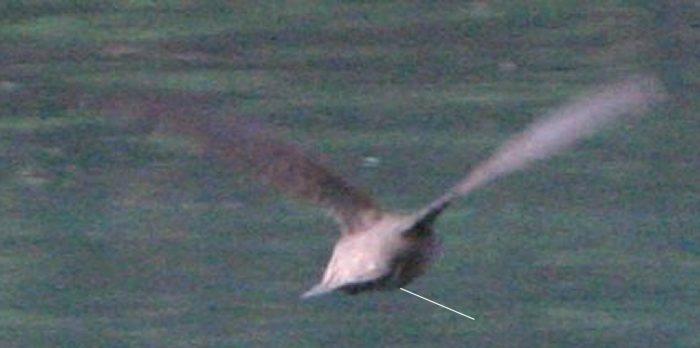
Note in the four images below how the contrastingly pale rump and uppertail coverts extend virtually to the tip of the tail:
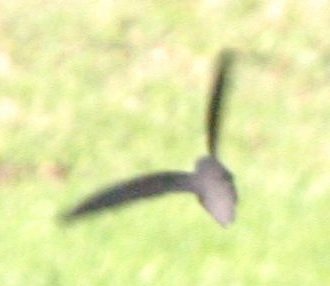
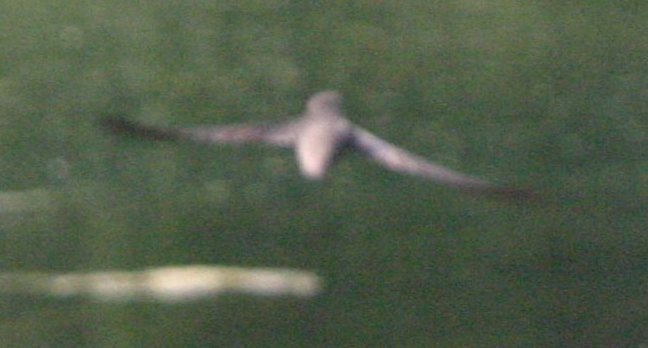
In the two images below the tail is spread, showing the upper side of the actual tail feathers - these are grayish, not dark, yet still darker than the contrastingly paler uppertail coverts:

There is no indication of spines at the tail-tip; these images may not be detailed enough to show such a feature, but it is interesting to note that Chaetura (andrei) meridionalis (see below) has extremely short spines - the longest barely more than 2mm, compared with the 7.5mm of Chimney Swift C. pelagicus.
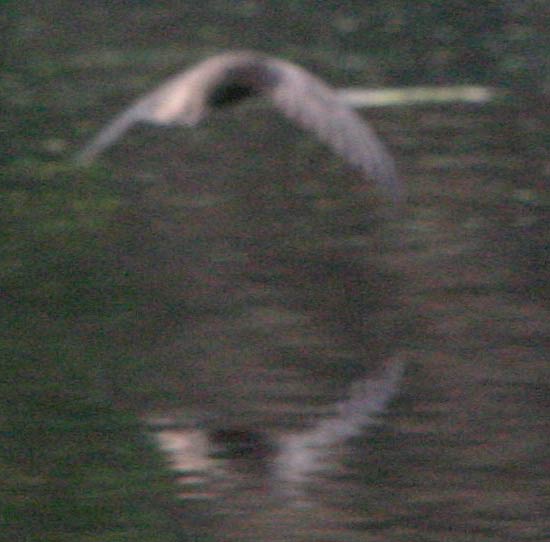
The combination of short tail, extensive pale rear-end (reaching the tail-tip), less-dark tail feathers, dark underparts with short contrasting whitish throat plus slightly paler undertail coverts, and small pale crescent ahead of the eye seem to match Chaetura (andrei) meridionalis - also known as Sick's Swift. The "Swifts" monograph (Chantler and Driessens 1995) states that paler undertail coverts are diagnostic of this species (including form andrei) and Short-tailed Swift C. brachyura. The form C. (a.) meridionalis is an Austral migrant, breeding in southern Brazil and northern Paraguay and Argentina from August - January (Oct - Nov in Matto Grosso, Brazil), and known from a small number of specimens and a few sightings from Venezuela, Colombia, and central Panama (once) from August and September, with one record from the Falkland Islands/islas Malvinas in March (probably a reverse-migrant). Migrants are known to be moving into the pan-Tepui region in May (per Sick 1993).
Update December 03, 2008: Here is another copy of the first photo of the Texas swift from above, sandwiched between pics of Sick's Swift from near Sao Paulo, Brazil on Nov 11, 2008:
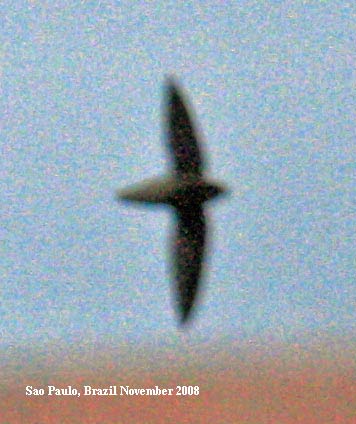

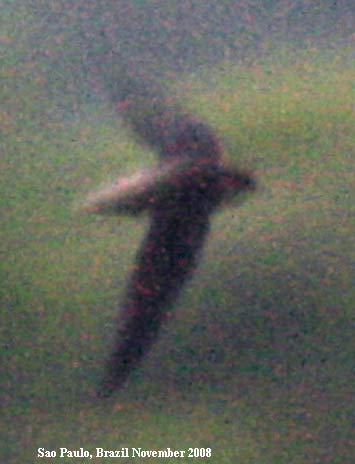
Here's another version of the above pic of Sick's Swift, and to its right is a copy of one of the other photos of the Texas bird:
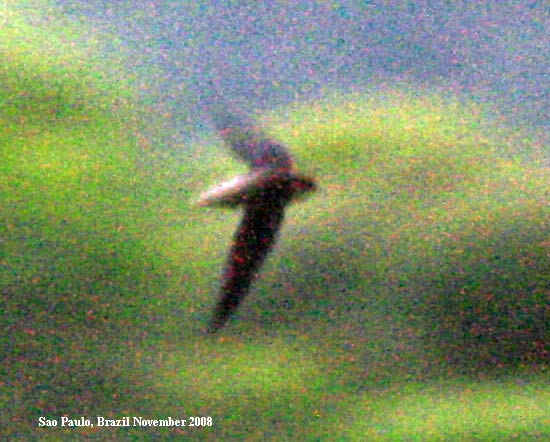

Update March 11, 2009: Here are two copies of pics from above which confirm that the paler undertail coverts are consistent;ly shown in every suitable image of the Texas bird:
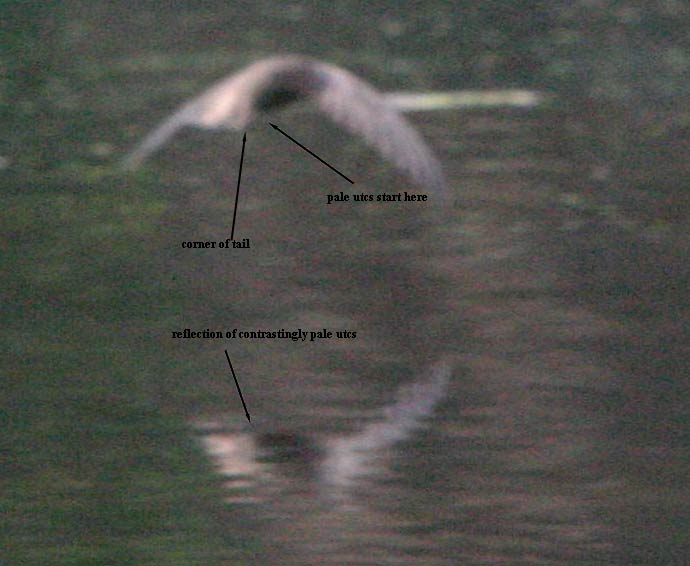
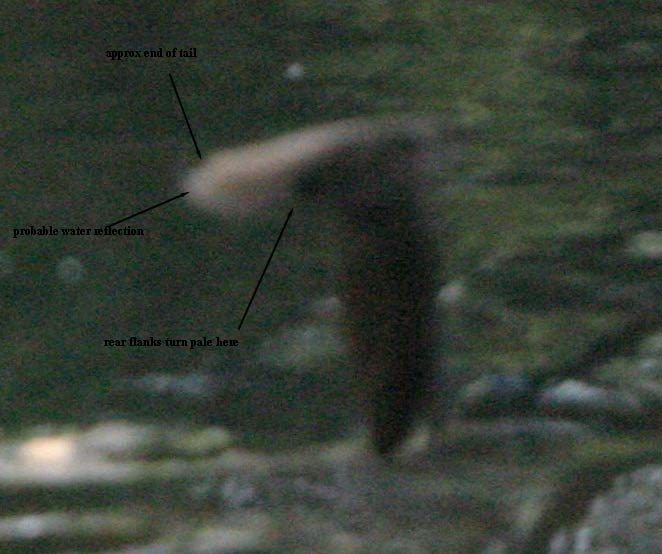
- and here is another actual Sick's Swift Chaetura meridionalis from SE Brazil showing a similar area of pale on the undertail covets:
